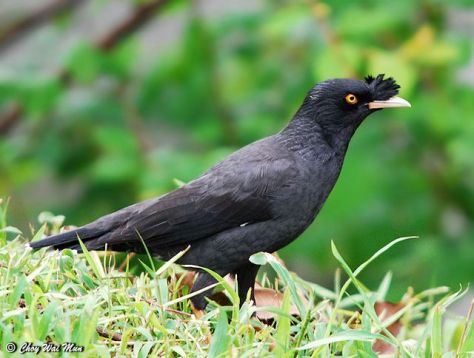As a follow-up to the article on our resident species on the blink of extinction we noted that some introduced species are also suffering the same fate, mainly due to an unsustainable small population. So, which of the introduced species in our Checklist are likely to have already gone extinct locally?
Under Category C in “The Avifauna of Singapore” there are 24 introduced bird species that have established a regular population which may, or may not be self-sustaining. They are in our current checklist as most have recorded breeding records over a period of time. We also have a Category E for species that are suspected to be captive birds that recently escaped. This is a longer list, and which may be closer to 150 species by now.
We can broadly divide these 24 species into three groups: (a) Common and Sustaining, (b) May not be sustained and (c) Likely extinct. Lineated Barbet, Tanimbar Corella, Red-breasted Parakeet, Common Pigeon, House Crow, Javan Myna, Sooty-headed Bulbul, White-crested Laughingthrush and Red-turtle Dove fall into the first group. The second group consist of species that does not appear to have sustaining populations on present evidence. They include the Wandering Whistling Duck, Yellow-crested Cockatoo, Rose-ringed Parakeet, Black-crested Bulbul, Red-whiskered Bulbul, Hwamei, Streaked Weaver, Red Avadavat, Rainbow Lorikeet, Javan Munia and House Sparrow. (We have breeding records for the last three species). There are four species that we believed have gone extinct as they have not been recorded for the past 20 years. The Black-winged Starling, Crested Myna, Java Sparrow and White-capped Munia are the subject of this article.
- Black-winged Starling, Sturnus melanopterus. (Photo: Jonathan Cheah)
This globally Endangered species is now very hard to see in its native range in Java and Bali. Some of the last significant populations persist in Baluran and Bali Barat national parks. Efforts are being made to reintroduce this species back into the wild. This species was thought to have been introduced into Singapore via the bird trade in the 1920 but seemed to have died out (Chasen 1935, 1939). In the 1980s two feral populations were recorded (Hails 1988b, MBR 1986-87). One was from Alexandra Estate and another at St. John’s Island, where breeding were recorded. There have been no records since the 15 January 1995 from St John’s Island (S. Abdullah, Lim Kim Seng), after discounting the one off sightings deemed to be escapees. This author recorded their breeding during a visit to St. John’s Island on 14 March 1993.
- Crested Myna Acridotheres cristatellus. (Phot0: Choy Wai Mun)
An introduced species to Penang (Medway & Wells 1976) from its native range in China, Northern Vietnam, Hainan and Taiwan (Clements 2007). It was introduced here probably in the early 80s with our first record in St. John’s Island on 2 April 1981 (MBR 1980-81). This population died out in 1995 (S. Abdullah. Lim Kim Seng). Mainland records came from Bras Basah Park on 23 November 1983 (Hails 1988b) and Changi. Our last record was an individual feeding with other mynas at Clementi Avenue on 22 February 1998 ( Lim Kim Seng per obs). There were no breeding records. This author’s record was from St. John’s Island on 14 March 1993.
- White-capped Munia Lonchura ferruginosa. (Photo: James Eaton)
The White-capped Munia is a grassland species, introduced here probably via the pet trade in the late 1980s. They originate from open country habitats in Java and Bali. In 1987 they were recorded from four different sites: Senoko on 28 February ( Lim K.S. 1987b), Serangoon on 28 September (SINAV 1.9), Kranji Reservoir on 14 October and Punggol on 15 October (SINAV 1.10). All records involved single birds. A year later, a flock of 30 were seen at Punggol on July followed by 11 seen in 1998. The last reported sighting was 2 birds at Punggol on 7 October 1990 (SINAV 4.6). It looks very much like our native White-headed Munia but has a black throat.
- Java Sparrow Padda oryzivora. (Photo: Khoo Siew Yoong).
Another native from Java and Bali that has been introduced to Sri Lanka and various parts of South-East Asia (e.g. Penang, Kota Kinabalu) (King et al 1975). It was listed as common in the late 20s by Bucknill and Chasen (1927). Gibson-Hill (1950) reported that they were seen in the town area together with Eurasian Tree Sparrows then. It went into a decline since with the last regular flock of some 20 birds occupying the Serangoon Sewage Works during the 1987-88 (SINAV 1:2). However this population died out with the last record of a single bird on 9 September 1988 (SINAV 2:9). There was a record of a single bird at the Old Airport Road Hawker Center on 1 September 2014 but this was considered a recently released bird. No recent breeding record has been reported.
The above records were from “The Avifauna of Singapore. 2009, by Lim Kim Seng” The compilation is by Alan OwYong with additional inputs from Yong Ding Li, who also edited the text with Francis Yap. Many thanks to Choy Wai Mun, James Eaton, Khoo Siew Yoong and Jonathan Cheah for the use of their photographs from the “Birds of Singapore” App.





I would occasionally come upon a small flock of four Crested Mynas ( Acridotheres cristatellus), within the Wild Africa zone of the Singapore Zoo whenever I had duty sessions in the late mornings as a Conservation Ambassador volunteer. My last sighting of this flock was in August 2016.
LikeLike
Hi Shaun, thanks for the interesting record. Are they in an enclosed space within the zoo?
Or free flying. Do you know how the zoo acquire these mynas?
As you know they are not native to Singapore and I am interested in its origin.
Thanks
LikeLike